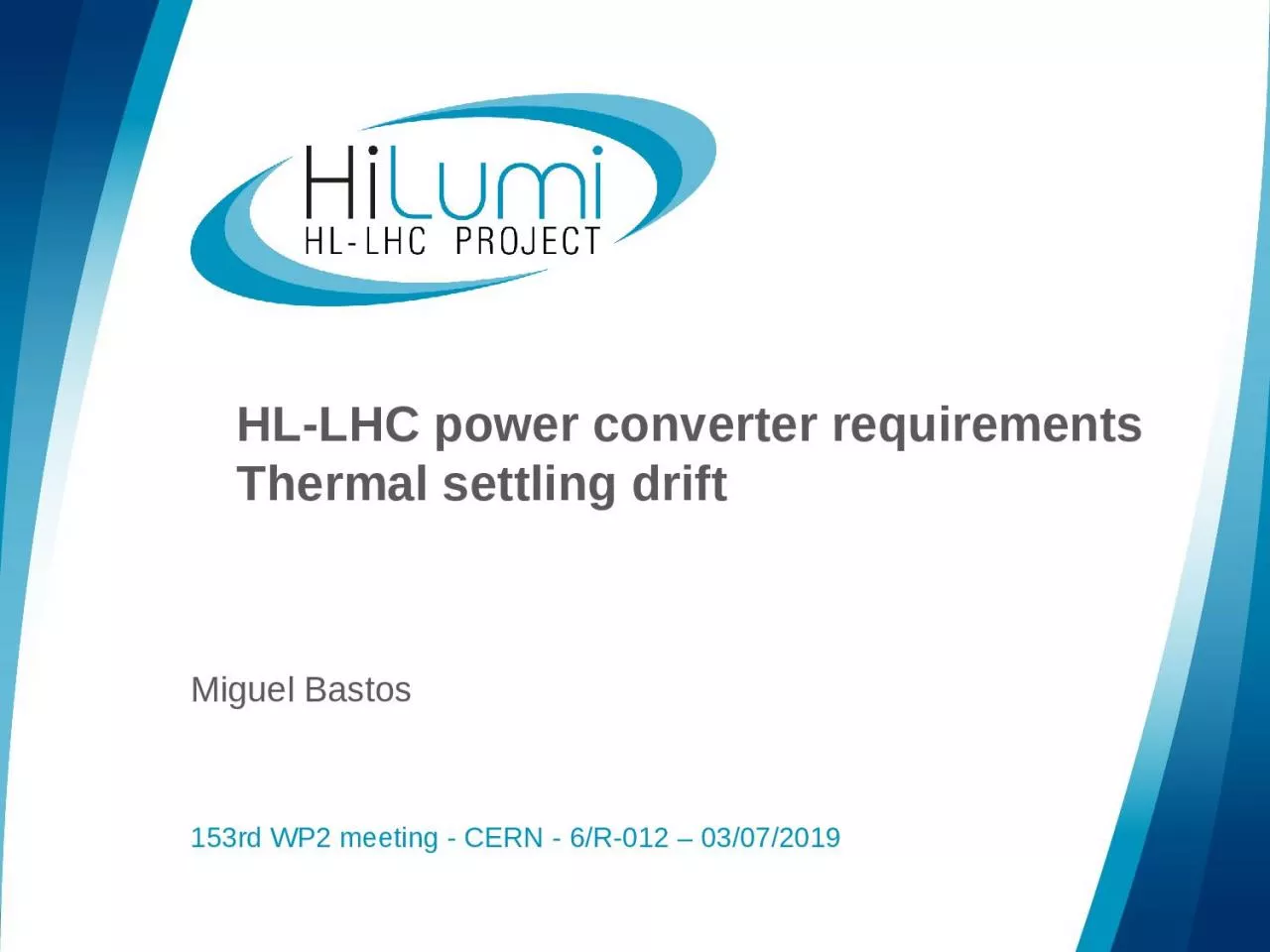

Thermal settling drift Miguel Bastos 153rd WP2 meeting CERN 6R012 03072019 HLLHC Power converter requirements Requirements were revised and approved this year new version of ID: 1026851
Download Presentation The PPT/PDF document "HL-LHC power converter requirements" is the property of its rightful owner. Permission is granted to download and print the materials on this web site for personal, non-commercial use only, and to display it on your personal computer provided you do not modify the materials and that you retain all copyright notices contained in the materials. By downloading content from our website, you accept the terms of this agreement.
1. HL-LHC power converter requirementsThermal settling drift Miguel Bastos153rd WP2 meeting - CERN - 6/R-012 – 03/07/2019
2. HL-LHC Power converter requirementsRequirements were revised and approved this year, new version of CERN-ACC-2017-0101 document to be releasedAs a reminder, values and definitions of some parameters were revised, and the effect of temperature considered separetely, as shown belowPC REQUIREMENTS SUMMARY - ACCURACY CLASSES01234Resolution [ppm]0.50.51.01.01.0Initial uncertainty after cal [2xrms ppm] normal2.02.03.07.010.0Linearity [ppm] [max abs ppm] uniform2.02.05.08.09.0Stability during a fill (12h) [max abs ppm] uniform0.71.95.08.09.5Short term stability (20min) [2xrms ppm] normal0.20.41.22.05.0Noise (<500Hz) [2xrms ppm] normal3.05.07.015.019.0Fill to fill repeatability [2xrms ppm] normal0.40.82.64.05.0Long term fill to fill stability [max abs ppm] uniform8.08.019.040.045.0Temperature coefficient [max abs ppm/C] uniform1.01.22.55.56.512h Delta T for HL-LHC [max C] constant0.51.05.05.05.01 y Delta T for HL-LHC [max C] constant0.51.05.05.05.001234Stability during a fill (12h) [2xrms ppm]1.02.615.533.139.1Fill to fill repeatability [2xrms ppm]0.71.614.732.037.9long term fill to fill stability [2xrms ppm]9.39.326.356.164.1
3. HL-LHC Power converter requirementsFor the HL-LHC, the temperature variations are known (estimated) and the TC can be used to recalculate some of the parameters:Stability during a fill (12h)Fill to fill repeatability Long Term stabilityFor example for Long Term Stability (LTS) the new uncertainty is: For the case of Filll to Fill Repeatibility (FFR), since this parameter is already given in 2*RMS, the calculation is as follows:(Details in EDMS 2048827)
4. HL-LHC Power converter requirementsPC REQUIREMENTS SUMMARY - ACCURACY CLASSES01234Resolution [ppm]0.50.51.01.01.0Initial uncertainty after cal [2xrms ppm] normal2.02.03.07.010.0Linearity [ppm] [max abs ppm] uniform2.02.05.08.09.0Stability during a fill (12h) [2xrms ppm]1.02.615.533.039.0Short term stability (20min) [2xrms ppm] normal0.20.41.22.05.0Noise (<500Hz) [2xrms ppm] normal3.05.07.015.019.0Fill to fill repeatability [2xrms ppm]0.71.614.532.038.0Long term fill to fill stability [2xrms ppm]9.59.526.556.064.0The final values are presented in 2 x RMS. resulting in the final table shown below..The distributions and limits of the parameters impacted by the temperature variation change with respect to the previous table. Details in EDMS doc 2048827
5. HL-LHC Power converter requirementsPC REQUIREMENTS SUMMARY - ACCURACY CLASSES01234Resolution [ppm]0.50.51.01.01.0Initial uncertainty after cal [2xrms ppm] normal2.02.03.07.010.0Linearity [ppm] [max abs ppm] uniform2.02.05.08.09.0Stability during a fill (12h) [max abs ppm] uniform0.71.95.08.09.5Short term stability (20min) [2xrms ppm] normal0.20.41.22.05.0Noise (<500Hz) [2xrms ppm] normal3.05.07.015.019.0Fill to fill repeatability [2xrms ppm] normal0.40.82.64.05.0Long term fill to fill stability [max abs ppm] uniform8.08.019.040.045.0Temperature coefficient [max abs ppm/C] uniform1.01.22.55.56.512h Delta T for HL-LHC [max C] constant0.51.05.05.05.01 y Delta T for HL-LHC [max C] constant0.51.05.05.05.001234Stability during a fill (12h) [2xrms ppm]1.02.615.533.139.1Fill to fill repeatability [2xrms ppm]0.71.614.732.037.9long term fill to fill stability [2xrms ppm]9.39.326.356.164.1The performance of power converters described above is essentially defined by:ADCs (Analogue to digital conversion), DCCTs (current measurement) and Current regulation loop -> Low FrequencyVoltage source and load -> Medium and high frequency
6. HL-LHC Power converter requirementsTherefore...Performance requirements for the power converter translate into even tighter performance requirements for ADCs and DCCTs. For example, class 0 requirement for 12h stability of a power converter is 0.7ppm and for the DCCT it is 0.5ppm.Class 0FGC3.2-EXT-AC-D0total PCdcct adcnotesResolution [ppm]0.5 0.2 Initial uncertainty after cal [2xrms ppm] normal2.01.01.0sum of rmsLinearity [ppm] [max abs ppm] uniform2.01.01.0sum of maxStability during a fill (12h) [max abs ppm] uniform0.70.50.2sum of maxShort term stability (20min) [2xrms ppm] normal0.20.10.1sum of rmsNoise (<500Hz) [2xrms ppm] normal3.02.01.0sum of rmsFill to fill repeatability [2xrms ppm] normal0.40.30.1sum of rmsLong term fill to fill stability [max abs ppm] uniform8.04.04.0sum of maxTemperature coefficient [max abs ppm/C] uniform1.00.80.2sum of max
7. HL-LHC Power converter requirementsDCCTs are power devices that measure high (e.g. 18kA) currents by transforming them down to smaller currents (e.g. 5A)A current step in the power converter corresponds to a current step in the DCCT and therefore a power dissipation stepAs a consequence, a drift due to thermal settling of the resistor used to measure the DCCT output current, is more likely to happen during ther first minutes after a current stepThe DCCTs
8. HL-LHC Power converter requirementsThe LHC ramps up the current in 10..20 minutes. On arrival to flat top we expect the DCCT to have higher drift in the first few minutes. Until now : this drift was included in the 12h stability specification, but if we exclude the initial 5 minutes after arrival to the flat top, a critical specification of the DCCT could be relaxedIt seems reasonable to assume that the machine doesn’t need to operate at full performance on arrival to the flat top (no physics), so...Can we consider a period of 5 minutes were the DCCTs are allowed to settle, before they have to perform within the 12h stability ? Impact for HL-LHC
9. HL-LHC Power converter requirementsIf yes, then the following new table is proposed, including a new specification:Stability at the end of ramp (5min): Variation of the delivered current (for a constant reference) during the first 5 minutes after the current reaches the flat topPC REQUIREMENTS SUMMARY - ACCURACY CLASSES01234Resolution [ppm]0.50.51.01.01.0Initial uncertainty after cal [2xrms ppm] normal2.02.03.07.010.0Linearity [ppm] [max abs ppm] uniform2.02.05.08.09.0Thermal settling drift - first 5 minutes of flat top [max abs ppm] uniform0.51.51.53.06.0Stability during a fill (12h) [2xrms ppm]1.02.615.533.039.0Short term stability (20min) [2xrms ppm] normal0.20.41.22.05.0Noise (<500Hz) [2xrms ppm] normal3.05.07.015.019.0Fill to fill repeatability [2xrms ppm]0.71.614.532.038.0long term fill to fill stability [2xrms ppm]9.59.526.556.064.0